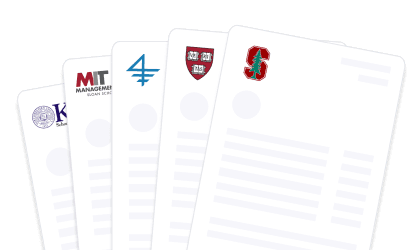
Table of Contents
When applying to top MBA programs, understanding the MBA acceptance rates and class profiles of each school is essential. It helps you make informed decisions about where to apply, based on your qualifications and career goals. This guide provides valuable insight into the acceptance rates, class profiles, and unique characteristics of the top business schools in the U.S. for 2025, including prestigious institutions like Harvard Business School, Stanford GSB, Wharton School, Columbia Business School, and others.
By examining the data on GMAT scores, average GPA, class size, and admissions process, you'll gain a clearer understanding of where you stand as an MBA applicant and which schools are the best fit for your aspirations. Whether you're aiming for a reach school or a safety school, this information will guide you in crafting a competitive MBA application.
For more information on how to get into top business schools, check out these free resources:
- The Complete MBA Application Guide
- How to Write a Powerful MBA Essay -- With Examples
- A Comprehensive MBA Application Timeline -- With Chart
Why Understanding MBA Acceptance Rates and Class Profiles Matters
For prospective students, the MBA acceptance rate is a crucial factor when choosing which schools to apply to. It’s a clear indicator of how competitive a program is and helps you assess your chances of gaining MBA acceptance. Knowing the class profiles, which include GMAT scores, average GPA, work experience, and demographic data, provides a deeper understanding of what successful applicants typically look like. By comparing this data with your own qualifications, you can decide which business schools are target schools and which are reach schools or safety schools.

MBA Application Checklist
Stay on track with your MBA apps. Get a full customizable checklist of what to do, when, and how to do it well.
MBA Acceptance Rates Overview
1. Stanford Graduate School of Business (GSB)
GSB Class Profile (2026)
- Women: 44%
- Students of Color: 53%
- International: 39%
- First-Generation: 12%
- Average Years of Work Experience: 5.1
- Average GPA: 3.75
- Average GMAT: 738
- Average GRE: 163 (Verbal), 164 (Quantitative)
GSB Acceptance Rate: 5-6%
- Number of Applicants: 7,295
- Class Size: 424
For more info on Stanford’s Graduate School of Business, check out:
- Stanford GSB MBA Curriculum - Core, Electives, & Specializations
- Stanford GSB MBA Essays: Prompts, Tips, & Examples
- Stanford GSB: MBA Tuition & Fees Breakdown
- The 5 Best Classes at Stanford's Graduate School of Business
2. Harvard Business School (HBS)
HBS Class Profile (2026)
- Women: 45%
- International: 35%
- First-Generation: 11%
- Average Years of Work Experience: 5
- Average GPA: 3.69
- Median GMAT: 740 (Verbal: 42, Quantitative: 49)
- Median GRE: 163 (Verbal and Quantitative)
HBS Acceptance Rate: 9%
- Number of Applicants: 9,856
- Class Size: 930
If you’re looking to get a better understanding of HBS, you’re in luck! Read our articles on all things HBS here:
- Applying to Harvard Business School: Story of a Current Student
- Harvard Business School MBA Essay: 5 Things to Do
3. University of Pennsylvania Wharton School of Business
Wharton Class Profile (2026)
- Women: 47%
- International: 31%
- LGBTQ+ Students: 10%
- First-Generation: 11%
- Average Years of Work Experience: 5
- Average GPA: 3.6
- Average GMAT: 732
- Average GRE: 162 (Verbal), 163 (Quant)
Wharton Acceptance Rate: 11-12%
- Number of Applicants: 7,322
- Class Size: 866
Read through some more of our resources on Wharton here:
4. University of Chicago Booth
Booth Class Profile (2024)
- Women: 42%
- Countries Represented: 66%
- International: 35%
- First-Generation: 11%
- LGBTQ+: 9%
- Veterans: 10%
- Average Years of Work Experience: 5
- Average GPA: 3.6
- Average GMAT: 730
- Average GRE: 161 (Verbal), 163 (Quantitative)
Booth Acceptance Rate: 12%
- Number of Applicants: 5,125
- Class Size: 632
For a better overview of Chicago Booth’s curriculum and admissions process, read through our resources here:
- Chicago Booth MBA Essays: 5 Expert Tips
- Chicago Booth MBA Class Profile: Key Insights & Takeaways
- How to Answer the “Why Booth?” Interview Question
5. Northwestern University Kellogg School of Management
Kellogg Class Profile (2026)
- Women: 50%
- First-Generation: 10%
- International: 40%
- LGBTQ+: 11%
- Average Years of Work Experience: 5
- Average GPA: 3.7
- Average GMAT: 733
- Median GRE: 162 (Verbal), 163 (Quantitative)
Kellogg Acceptance Rate: 20-21%
- Number of Applicants: *This year's numbers have not been released
- Class Size: 524
Check out more on Kellogg’s MBA program with the following resources:
6. Massachusetts Institute of Technology Sloan
Sloan Class Profile (2026)
- Women: 49%
- Minority Students: 15%
- First-Generation: 10%
- International: 40%
- Average Years of Work Experience: 5
- Average GPA: 3.7
- Median GMAT: 730
- GRE Range: 157-168 (Verbal), 159-170 (Quantitative)
Sloan Acceptance Rate: 17.8%
- Number of Applicants: *This year's numbers have not been released
- Class Size: 433
For more information on MIT Sloan, read our guides:
7. Columbia University Business School
Columbia Class Profile (2026)
- Women: 44%
- Minority Students: 43%
- International: 47%
- Average Years of Work Experience: 5
- Average GPA: 3.5
- Average GMAT: 730
Columbia Acceptance Rate: 15.26%
- Number of Applicants: 5,895
- Class Size: 900
Read more articles on Columbia Business School’s MBA programs here:
8. University of California, Berkeley Haas School of Business
Haas Class Profile (2026)
- Women: 42%
- Minority Students: 51%
- First-Generation: 15%
- International: 38%
- LGBTQ+: 19%
- Veterans: 7%
- Average Years of Work Experience: 5.6
- Average GPA: 3.65
- Average GMAT: 730
- Average GRE: 161 (Verbal), 162 (Quant)
Haas Acceptance Rate: 17.6%
- Number of Applicants: *This year's numbers have not been released
- Class Size: 295
If you’re looking to get a better understanding of Berkeley Haas, we recommend looking through some of our articles here:
- Berkeley Haas MBA Essays Guide: Overview, Tips & Examples
- How to Nail Your Berkeley Haas MBA Interview: Overview, Questions, & Tips
9. Yale University School of Management (SOM)
Yale SOM Class Profile (2026)
- Women: 39%
- Students of Color: 56%
- International: 48%
- LGBTQ+: 12%
- First-Generation: 20%
- Average Years of Work Experience: 4.9
- Average GPA: 3.69
- Median GMAT: 730
- Median GRE: 164 (Verbal), 166 (Quantitative)
Yale SOM Acceptance Rate: 23.7%
- Class Size: 347
Curious to learn more about Yale SOM? Look no further! Read our articles here:
- Yale SOM MBA Essays Guide: Overview, Tips & Examples
- How to Nail Your Yale SOM MBA Interview: Overview, Questions, & Tips
10. Dartmouth College Tuck School of Business
Tuck Class Profile (2026)
- Women: 44%
- Minority Students: 29%
- International: 30%
- LGBTQ+: 7%
- Students with children: 4%
- First-Generation: 15%
- Average GPA: 3.6
- Average GMAT: 727
- Average GRE: 161 (Verbal), 161 (Quantitative)
Tuck Acceptance Rate: 22-23%
- Class Size: 296
Read more on Dartmouth’s MBA program here:
- Dartmouth Tuck MBA Essays Guide: Overview, Tips & Examples
- How to Nail Your Dartmouth Tuck MBA Interview: Overview, Questions, and Tips
Coach Recommendations
To give yourself the best chance of getting into a top MBA program, we highly recommend working with a Leland expert MBA admissions coach. Below are some of our top coaches. Browse all of them here.
11. New York University Stern School of Business
Stern Class Profile (2026)
- Women: 47%
- Minority Students: 46%
- International: 40%
- LGBTQ+: 11%
- Veterans/Active Duty: 11%
- Average Years of Work Experience: 5
- Average GPA: 3.64
- Average GMAT: 733
- Average GRE: 164 (Verbal), 164 (Quantitative)
Stern Acceptance Rate: 25.7%
- Number of Applicants: 4,550
- Admitted Students: 1,141
- Class Size: 352
For a better overview of NYU Stern’s programs, read our articles here:
- How to Nail the NYU "Pick Six" MBA Application Essay
- How to Nail Your NYU Stern MBA Interview: Overview, Questions, & Tips
12. Duke University Fuqua School of Business
Fuqua Class Profile (2026)
- Women: 51%
- Students with Color: 56%
- First-Generation: 18%
- International: 41%
- Military: 11%
- Have a Partner: 37%
- Average Years of Work Experience: 6
- Average GPA (middle 80%): 3.17-3.89
- GMAT Range: 660-760
- GRE Range: 305-330
Fuqua Acceptance Rate: 22-25%
- Class Size: 427
If you’re looking for more info on Duke’s MBA program, check out our articles here:
- Duke Fuqua MBA Essays Guide: Overview, Tips & Examples
- How to Nail Your Duke Fuqua MBA Interview: Overview, Questions, & Tips
13. University of Michigan, Ann Arbor Ross School of Business
Ross Class Profile (2026)
- Women: 40%
- Students of Color: 53%
- International: 36%
- LGBTQIAS+: 9%
- Military: 15%
- First Generation: 22%
- Average Years of Work Experience: 6
- Average GPA: 3.42
- Average GMAT: 728
- Average GRE: 159 (Verbal), 162 (Quantitative)
Ross Acceptance Rate: 20%
- Class Size: 396
14. University of Virginia Darden School of Business
Darden Class Profile (2026)
- Women: 38%
- Minority Students: 23%
- International: 30%
- Military: 14%
- Average Years of Work Experience: 5.7
- Average GPA: 3.56
- Average GMAT: 718
- Average GRE: 321 (combined)
Darden Acceptance Rate: 26-36%*
*Estimates vary within this range.
- Class Size: 355
Read more about Darden at our guides here:
- Why I Chose Darden for My MBA Program
- How to Nail Your UVA Darden MBA Interview: Overview, Questions, & Tips
15. Cornell University Johnson Graduate School of Management
Johnson Class Profile (2026)
- Women: 41%
- Underrepresented Minorities: 22%
- International: 35%
- US Military: 13%
- Average Years of Work Experience: 5.3
- Median GPA: 3.4
- Median GMAT: 710
- Average GRE: 320 (combined)
Johnson Acceptance Rate: 39.6%
- Class Size: 282
Want more information on Cornell Johnson’s MBA program? Read through some of our articles here:
16. Carnegie Mellon University Tepper School of Business
Tepper Class Profile (2026)
- Women: 31%
- Minority Students: 52%
- International: 39%
- LGBTQ+: 11%
- Average Years of Work Experience: 5.7
- Average GPA: 3.25
- Average GMAT: 700
- Average GRE: 323 (combined)
Tepper Acceptance Rate: 27%
- Class Size: 156
17. University of Southern California Marshall School of Business
Marshall Class Profile (2026)
- Women: 35%
- Students of Color: 20%
- International: 41%
- LGBTQ+: 9%
- US Military: 10%
- Average Years of Work Experience: 5.5
- Average GPA: 3.5
- Average GMAT: 722
- Average GRE: 160 (Verbal), 163 (Quant)
Marshall Acceptance Rate: 28-30%
- Class Size: 199
18. University of California, Los Angeles Anderson School of Management
Anderson Class Profile (2026)
- Women: 43%
- LFBTQ+: 8%
- US Military: 4%
- International: 41%
- Average Years of Work Experience: 5.4
- GPA Range (middle 80%): 3.1-3.8
- Average GMAT: 714
- Average GRE: 162 (Verbal), 165 (Quantitative)
Anderson Acceptance Rate: 9.9%
- Number of Applicants: 3,079
- Class Size: 305
Check out more on UCLA’s MBA program with our guides here:
- The UCLA Anderson MBA Program: Expectation Vs. Reality
- UCLA Anderson MBA Essays Guide: Overview, Tips & Examples
- How to Nail Your UCLA Anderson MBA Interview: Overview, Questions, & Tips
19. University of Texas at Austin McCombs School of Business
McCombs Class Profile (2026)
- Women: 33%
- Minority Students: 23%
- International: 29%
- US Military: 14%
- First-Generation: 15%
- Average Years of Work Experience: 6
- Average GPA: 3.48
- Average GMAT: 704
- Average GRE: 159 (Verbal), 162 (Quantitative)
McCombs Acceptance Rate: 28.5%
- Class Size: 255
- Dual Degree Students: 22%
20. University of North Carolina, Chapel Hill, Kenan-Flagler Business School
Kenan-Flagler Class Profile (2026)
- Women: 31%
- International: 43%
- Military: 12%
- Average Years of Work Experience: 5
- Average GPA: 3.42
- Average GMAT: 707
Kenan-Flagler Acceptance Rate: 44-51%
- Class Size: 249
21. Georgetown University McDonough School of Business
McDonough Class Profile (2024)
- Women: 30%
- Minority Students: 14%
- International: 49%
- Military: 12%
- Average Years of Work Experience: 5.6
- Average GPA: 3.3
- Average GMAT: 696
- Average GRE: 319 (combined)
McDonough Acceptance Rate: 16.2%
- Number of Applicants: 1,642
- Class Size: 263
22. University of Washington Foster School of Business
Foster Class Profile (2026)
- Women: 32%
- Students of Color: 59%
- International: 46%
- First-Generation: 16%
- Military: 29%
- Average Years of Work Experience: 6
- Average GPA: 3.4
- Average GMAT: 700
- Average GRE: 159 (Verbal), 160 (Quantitative)
UW Foster Acceptance Rate: 40-41%
- Class Size: 118
23. Indiana University (Bloomington) Kelley School of Business
Kelley Class Profile (2026)
- Women: 28%
- Minority Students: 21%
- International: 46%
- Average Years of Work Experience: 6.3
- Average GPA: 3.40
- Average GMAT: 683
- Average GRE: 158 (Verbal), 161 (Quant)
IU Kelley Acceptance Rate: 38%
- Class Size: 103
24. Vanderbilt University Owen Graduate School of Management
Owen Class Profile (2026)
- Women: 29%
- Minority Students: 19%
- International: 30%
- Military: 22%
- Average Years of Work Experience: 6
- Median GPA: 3.4
- Average GMAT: 703
- Average GRE: 159 (Verbal), 159 (Quantitative)
Owen Acceptance Rate: 35-40%
- Class Size: 175
25. Rice University Jones Graduate School of Business
Jones Class Profile (2026)
- Women: 39%
- Minority Students: 57%
- International: 41%
- First-Generation: 27%
- Average Years of Work Experience: 5.3
- Average GPA: 3.44
- Average GMAT: 698
- Average GRE: 157 (Verbal), 160 (Quantitative)
Jones Acceptance Rate: 39.5%
- Class Size: 158
Check out more on Rice University’s MBA program with our guides here:
These numbers give a good rough estimate of the class profiles and application cutoffs. However, applications change every year depending on the number and profile of the applicants, the school’s priorities, and may not line up exactly with past years. Compile the best application you can, and shoot for the stars!
The Bottom Line
When choosing an MBA program, it is important to understand the MBA acceptance rates and class profiles of top US business schools. This data helps you determine which schools are the best fit for your qualifications and career goals.
Knowing these factors will guide you in choosing the right MBA program and making an informed decision about whether a school is a target school or a reach school. Focus on schools that align with your skills, knowledge, and future investment in your career. With the right strategy, you can apply confidently and increase your chances of MBA acceptance.
Get Into Your Dream Business School With the Help of an Expert
The best way to increase your odds of admission to an MBA program is to work with an expert who has been there and can provide personalized guidance based on your background and goals. Below are several popular coaches. Browse all here.
Read next:
- Rejected From an MBA Program? Here's What to Do Next
- An Expert Coach's Top Tips for Non-Traditional MBA Applicants
- A Guide to the Columbia Business School Essays (2023-2024)
- Top MBA Programs for Product Management
- Top MBA Programs for Investment Banking
FAQs
How Hard is it to Get Accepted for an MBA?
- Getting accepted to an MBA program, especially at top business schools, can be competitive, but it’s not impossible. Strong GMAT scores, relevant work experience, and a well-crafted application strategy are key factors in improving your chances. Consider applying to safety schools if your qualifications don't match the top programs' profiles.
What GPA is Too Low for MBA?
- While most top programs prefer a GPA of 3.5 or higher, it’s not the only factor. Schools like Michigan Ross may be more flexible, especially if you have strong work experience or GMAT scores to back up your application.
Is MBA Value Declining?
- An MBA’s value is still significant, especially from top business schools with strong alumni networks and access to top employers. However, its worth depends on the program you choose and how well it aligns with your career goals.
Is MBA Hard for an Average Student?
- An MBA can be challenging for anyone, but it’s achievable for average students with dedication. The key is focusing on knowledge and building skills in areas like leadership and management, while considering safety schools if you're unsure about the most competitive programs.


















